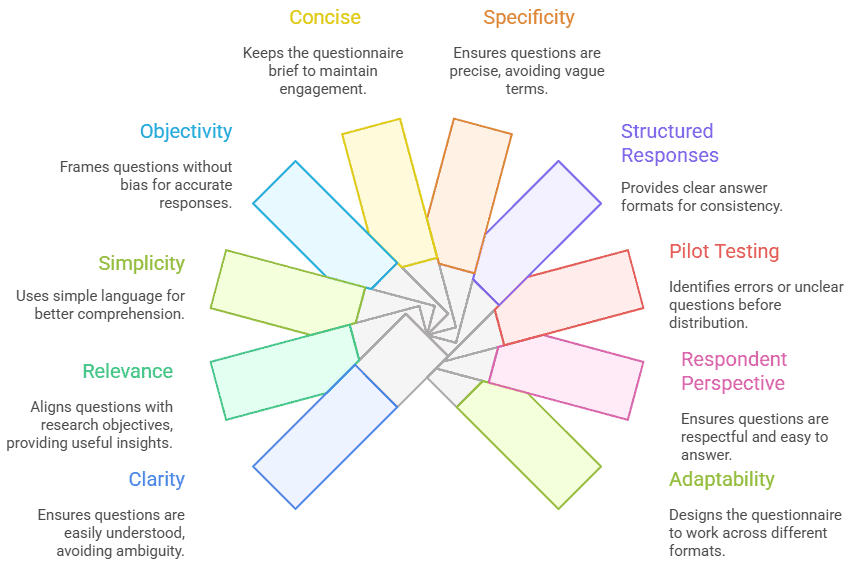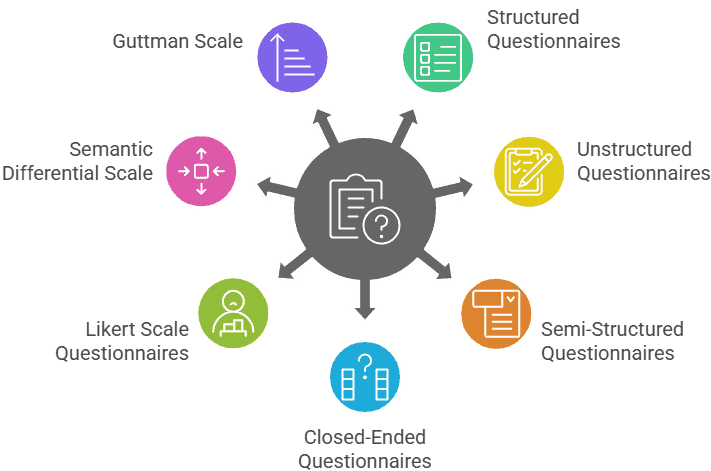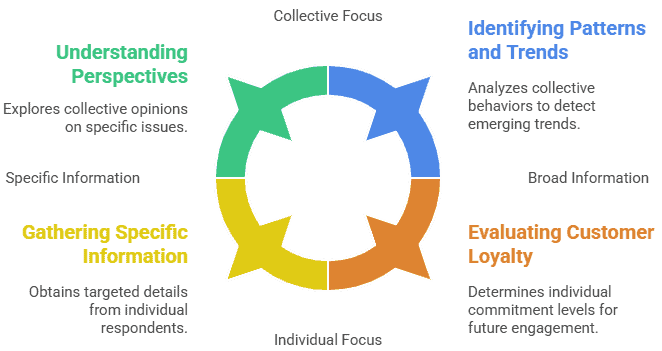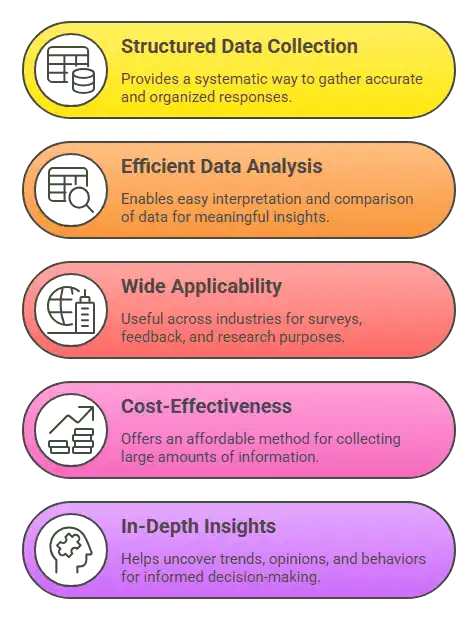Key Takeaways:
- What is a Questionnaire? A structured set of questions to collect data, feedback, or opinions.
- Key Features: Clear, relevant, simple, and concise.
- Types: Structured, Semi-Structured, Likert Scale, Semantic Differential, Guttman.
- Benefits: Easy to collect, cost-effective, provides actionable insights.
- Cautions: Limited depth, potential bias, privacy considerations.
A questionnaire is a research tool used to collect data, opinions, and insights from a target audience. It typically consists of a set of structured or unstructured questions designed to gather quantitative or qualitative information. From academic research to customer feedback and employee engagement, questionnaires play a vital role in decision-making across industries. In this blog, we’ll explore what a questionnaire is, its key benefits, different types, and real-world examples to help you understand its importance and application, and how to create a questionnaire for research.
What is a Questionnaire?
A questionnaire is a structured set of questions designed to collect information from respondents for research, surveys, or evaluations. It can include open-ended or closed-ended questions and is widely used in academic studies, market research, customer feedback, and social science to gather data efficiently and systematically.
Characteristics of a Good Questionnaire

- Clarity: Questions should be easy to understand, avoiding ambiguity or complex language.
- Relevance: Each question must align with the research objective and provide useful insights.
- Simplicity: Use simple language and keep questions straightforward for better comprehension.
- Objectivity: Frame questions without bias to ensure accurate and honest responses.
- Concise: Keep the questionnaire brief and focused to maintain respondent engagement.
- Specificity: Questions should be precise, avoiding vague or generalized terms.
- Structured Responses: Provide clear answer formats like multiple choice or scales for consistency.
- Pilot Testing: Test the questionnaire with a small group to identify errors or unclear questions.
- Consideration of Respondent Perspective: Ensure the questions are respectful, relevant, and easy to answer for your audience.
- Adaptability: Design it to work across different formats, such as online, paper, or interviews.
Types of Questionnaires with Examples
Questionnaires come in various formats depending on the research goal and type of data required. They can be structured for quantitative analysis or unstructured for qualitative insights. Understanding these types helps researchers choose the most effective format for collecting accurate and meaningful data.

Structured Questionnaires
These questionnaires contain predefined questions and fixed response options, making them highly systematic and easy to analyse. They are commonly used in quantitative research to collect measurable data efficiently. Let’s look at a questionnaire example of this:
Example:
Q1. How many hours do you work per day?
- 4–6 hours
- 6–8 hours
- 8–10 hours
- More than 10 hours
Unstructured questionnaires
These questionnaires allow respondents to answer in their own words without predefined options. They provide richer qualitative insights and are ideal for exploring opinions, feelings, and experiences.
Example:
Q1. What do you think about the work culture in your company?
Semi-Structured Questionnaires
A blend of structured and unstructured formats, these questionnaires include both closed-ended and open-ended questions. They provide quantitative data while also capturing qualitative details for deeper understanding.
Example:
Q1. How often do you exercise?
- Daily
- Weekly
- Monthly
- Rarely
Q2. If rarely, what prevents you from exercising regularly? (Open-ended)
Closed-Ended Questionnaires
These questionnaires require respondents to select from predetermined options. They are quick to answer and easy to analyze statistically.
Example:
Q1. Which social media platform do you use most?
- X (Twitter)
Likert Scale Questionnaires
These questionnaires measure attitudes or opinions on a scale, usually ranging from strong agreement to strong disagreement. They help in quantifying subjective views, making it easier to analyze trends and sentiments. Learn more about Likert scale questions here.
Example:
Q1. I am satisfied with my current work-life balance.
- Strongly Agree
- Agree
- Neutral
- Disagree
- Strongly Disagree
Semantic Differential Scale
This type of questionnaire uses a set of bipolar adjectives (e.g., helpful–unhelpful) placed on a scale, allowing respondents to express their attitude toward a concept or service. It is often used to assess brand perception or customer satisfaction.
Example:
Q1. How would you rate our customer service?
Helpful ⬜⬜⬜⬜⬜ Unhelpful
Friendly ⬜⬜⬜⬜⬜ Unfriendly
The Guttman Scale
The Guttman Scale measures the intensity of a respondent’s opinion by presenting statements in increasing order of difficulty or extremity. If a respondent agrees with a higher-order statement, it is assumed they agree with all previous ones.
Example (about environmental concern):
Q1. I recycle waste regularly.
Q2. I avoid single-use plastics.
Q3. I use only eco-friendly products.
Q4. I participate in environmental activism.
If a respondent agrees with Q4, it’s assumed they also agree with Q1–Q3.
Objectives of a Questionnaire
A well-designed questionnaire aims to collect accurate and relevant data to support research or decision-making. Its key objectives include:

- Gathering Specific Information – To obtain targeted details on a particular topic or issue.
- Understanding Perspectives – To explore opinions, attitudes, and viewpoints of respondents.
- Measuring Satisfaction and Feedback – To assess user experience, service quality, or product performance.
- Identifying Patterns and Trends – To analyze behaviors and detect emerging trends for strategic planning.
- Evaluating Customer Loyalty – To determine commitment levels and predict future engagement or retention.
Importance of Questionnaires
Questionnaires play a vital role in research and business decision-making because they:

- Structured Data Collection – Provide a systematic way to gather accurate and organized responses.
- Efficient Data Analysis – Enable easy interpretation and comparison of data for meaningful insights.
- Wide Applicability – Useful across industries for surveys, feedback, and research purposes.
- Cost-Effectiveness – Offer an affordable method for collecting large amounts of information.
- In-Depth Insights – Help uncover trends, opinions, and behaviors for informed decision-making.
Advantages of Questionnaires
- Efficiency
- Cost-Effectiveness
- Anonymity Encourages Honest Responses
- Longitudinal Studies
Disadvantages of Questionnaires
- Limited Depth of Responses
- Potential for Biased Responses
- Difficulty in Interpreting Open-Ended Questions
- Data Security and Privacy Concerns
Create engaging surveys and questionnaires effortlessly with Interactico

FAQs
How do you order a questionnaire?
To create an effective questionnaire, start by defining your objective, then craft clear and concise questions that align with your goal. Once ready, you can design it using tools like Interactico and share it with your audience.
How do you administer questionnaires?
You can distribute questionnaires online through email, social media, or survey platforms for quick responses, or use paper forms for in-person data collection, whichever suits your audience best.
Questionnaires are a powerful tool for collecting valuable data, whether for understanding customer satisfaction, conducting research, or identifying trends. Their structured approach makes data collection easier, faster, and more cost-effective. By choosing the right type of questionnaire and administering it effectively, businesses and researchers can gain deep insights that drive informed decisions. Whether online or offline, a well-designed questionnaire is key to turning opinions into actionable strategies.


